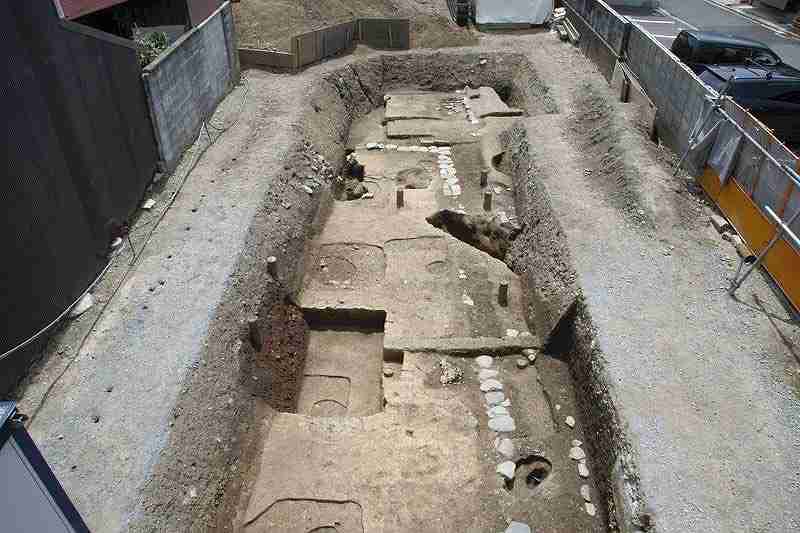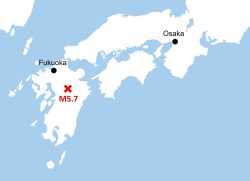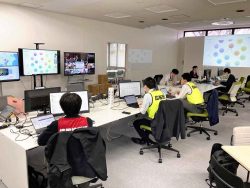
The excavated remains of the Tokaden in Kamigyo Ward, Kyoto. The hole for a pillar can be seen on the left.
November 16, 2021
KYOTO — The remains of structures found on the site of the former imperial palace in Kyoto have been confirmed as having housed empresses and court ladies during the Heian period (794-late 12th century), it was recently announced.
The Kyoto City Archaeological Research Institute confirmed that the remains are of the “Tokaden” and “Kokiden” dwellings that were part of the Heian-kyu palace, the emperors’ residential compound in ancient Kyoto.
The buildings, which are mentioned in classic works from the period such as “The Pillow Book” and “The Tale of Genji,” are believed to have been built around the time the capital was relocated to Kyoto in 794 based on excavated earthenware and other items.
It marks the first time that remains of imperial palace structures from the Heian period have been confirmed.
In 2015, the institute conducted an archaeological survey on a 145-square-meter plot on the Heian-kyu palace site in Kyoto’s Kamigyo Ward. Based on the layout of buildings and other information contained in the “Daidairizu Kosho,” a reference book of records on the Heian-kyu palace written in the Edo period, the researchers concluded that the remains were those of the Tokaden and Kokiden.
The Tokaden was one of 17 residential structures in the Heian-kyu palace, and was located to the northwest of the Shishinden, the hall for state ceremonies where the emperors held important functions. It is estimated to have been 25 meters long from north to south and 10 meters long from east to west, including eaves.
This would have been the residence of Emperor Ichijo’s Empress Teishi as well as Sei Shonagon, an attendant to Empress Teishi who wrote The Pillow Book.
The Kokiden, adjacent to the south, is depicted by Murasaki Shikibu in The Tale of Genji as the place in which Hikaru Genji meets Oborozukiyo.
In the presumed location of the Tokaden, pillar holes measuring 0.9 to 1.8 meters square were excavated at intervals of about 3 meters in five locations running from north to south. Nearby were confirmed remains of stone drainage canals, a feature of upper-class facilities, that were over 11 meters long from north to south and more than 2.3 meters from east to west.
Likewise, a drainage canal of more than 1.1 meters in length was excavated at the presumed Kokiden site, along with two stones believed to be used in the foundation of the corridor connecting to the structures.
“Amid the long history of repeatedly rebuilding and expansion, being able to confirm the remains of buildings from around the time of the relocation of the capital is a valuable find,” said Tamiki Kunishita, professor of history of ancient Japanese castles at Ryukoku University.
"Society" POPULAR ARTICLE
-

M4.9 Earthquake Hits Tokyo, Neighboring Prefectures
-

M7.5 Earthquake Hits Northern Japan; Tsunami Waves Observed in Hokkaido, Aomori and Iwate Prefectures
-

Tsukiji Market Urges Tourists to Avoid Visiting in Year-End
-

Israeli Tourists Refused Accommodation at Hotel in Japan’s Nagano Pref., Prompting Protest by Israeli Embassy and Probe by Prefecture
-

M5.7 Earthquake Hits Japan’s Kumamoto Pref., Measuring Upper 5 Intensity, No Tsunami Expected
JN ACCESS RANKING
-

Keidanren Chairman Yoshinobu Tsutsui Visits Kashiwazaki-Kariwa Nuclear Power Plant; Inspects New Emergency Safety System
-

Imports of Rare Earths from China Facing Delays, May Be Caused by Deterioration of Japan-China Relations
-

University of Tokyo Professor Discusses Japanese Economic Security in Interview Ahead of Forum
-

Japan Pulls out of Vietnam Nuclear Project, Complicating Hanoi’s Power Plans
-

Govt Aims to Expand NISA Program Lineup, Abolish Age Restriction






















